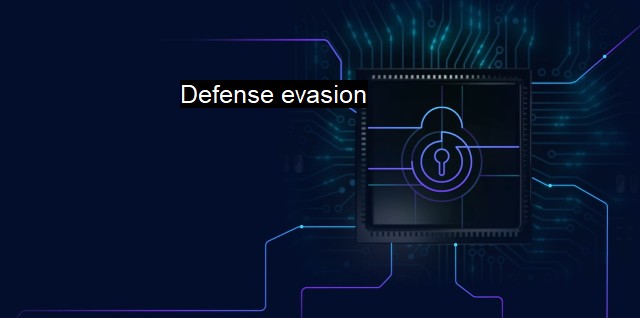What is Defense evasion?
Why Defense Evasion has Become Crucial in Modern Cybersecurity: Understanding the Techniques Used to Bypass Detection Measures and Trick Security Products
"Defense evasion" is a prevalent term in the world of cybersecurity and antivirus. As its name suggests, it refers to the myriad tactics, techniques, and procedures that hackers or malicious entities employ to avoid detection from the normally efficient security protocols or antivirus systems in place. Defense evasion is crafted such that malicious activities fuse seamlessly with normal processes and activities, making them almost invisible to regular security check protocols.The implementation of defense evasion sprouts ahead of the foothold phase of a cyber-attack. It is the accelerant that allows the assailants unprecedented access to an organization's or individual's digital estate while avoiding detection. A successful implementation could wreak havoc and compromise the safety and integrity of resources before any form of mitigation can take place.
There are various methods that attackers employ to evade defense mechanisms. One traditional approach commonly exploited involves disguising malware as regular, harmless files or software. Modern antivirus systems work on rules and lists where known threats are documented. by disguine malware as legal files, it makes it harder for antivirus systems to recognize the threat as it does not match anything on the list. This kind of evasion is highly effective and desolating since it could allow full access and control to an unsuspecting victim's resources.
Encrypting payloads is another commonly used defense evasion techniques. Sophisticated encryption methods make it formidable for antivirus software to detect the threat. Even should the payload be subjected to evaluation, the encryption would suppress any attempt at determining the content, rendering the payload ostensibly risk-free. The encrypted payload can then be dispatched to vulnerable sites or systems where it decodes and instigates an attack.
Attackers also exploit existing software vulnerability for defense evasion. By identifying and exploiting these vulnerabilities, they manage to break or bypass security defenses before launching any malicious operations. The breaching stage is vital because it establishes the beachhead that is instrumental in augmenting the attack.
Defense evasion also extends to digital anomalies that are intentionally implemented to camouflage illicit activities. These anomalies create a kind of digital noise that distracts security systems towards areas where there are no serious threats while enabling attackers to bury harmful cyber activities within this noise.
The implementation of distinct defense evasion methods also varies depending on the system targeted. In host-based security systems, attackers might manipulate the execution pathway of the system, mimicking valid processes, usage of legitimate credentials, or altering timestamps to blend cyber threats with normal activities. In the case of network-based security systems, evasion techniques might involve fragmenting unauthorized cyber packets or encrypting network traffic to stall threat detection.
It is equally important to note the more evolved instance of defense evasion: living off the land (LOTL). This approach leverages legitimate processes within a system to stage an attack. Here, the attackers either uses pieces of software native to the operating system or legitimate admin tools, thus making it extremely difficult to distinguish malicious activities from normal operations.
With the transformational role that interconnectivity and the internet play in today's era, coupled with the rising sophisticated nature of cyber threats, protection mechanisms cast a wider net and intensify their detection efforts. In this light, combating defense evasion pivots on a variety of strategies, including continual cybersecurity capacity development, enhancing detection capabilities, running frequent, unanticipated systems check, and improved network segmentation. keeping abreast of the ever-evolving landscape of cyber threats will shape defenses, enabling timely detection, isolation, and mitigation of attacks.

Defense evasion FAQs
What is defense evasion in cybersecurity?
Defense evasion is a technique used by hackers to bypass or evade the defenses of a target system. In cybersecurity, defense evasion refers to any attempt to avoid detection or prevention by antivirus software, intrusion detection systems, or other security measures.How do cyber attackers employ defense evasion techniques?
Cyber attackers use a variety of defense evasion techniques, including obfuscation, encryption, and polymorphism to hide their malicious activities. They may also use fileless malware, rootkits, and other advanced techniques to avoid detection and stay hidden in the target system for as long as possible.What can organizations do to protect themselves from defense evasion attacks?
To protect themselves from defense evasion attacks, organizations should deploy multiple layers of defense, including antivirus software, intrusion detection systems, and firewalls, among others. They should also ensure that their security tools stay updated with the latest threat intelligence and have a robust incident response plan in place to quickly detect and respond to any breaches.How can endpoints be protected from defense evasion attacks?
Endpoints can be protected from defense evasion attacks by deploying endpoint protection solutions that use behavioral analysis and machine learning algorithms to detect and block advanced threats. Organizations should also implement security best practices such as enforcing software updates, restricting user privileges, and educating employees on how to recognize and report suspicious activities.| | A | | | B | | | C | | | D | | | E | | | F | | | G | | | H | | | I | | | J | | | K | | | L | | | M | |
| | N | | | O | | | P | | | Q | | | R | | | S | | | T | | | U | | | V | | | W | | | X | | | Y | | | Z | |
| | 1 | | | 2 | | | 3 | | | 4 | | | 7 | | | 8 | | |||||||